Author: Dr. Rodrigo S. Reis
In restorative dentistry, composite resins – or simply resins or composites– have been the most versatile materials since their commercial launch in the early 1970s.
Along with adhesive techniques, these materials have revolutionized restorative concepts and techniques. Esthetics and preservation of healthy tooth structure gained progressive prominence and are currently considered key points since restorative bases prioritize the minimally invasive approaches. Adhesion is key to marginal integrity, restoration retention and stability and esthetics is gained through the optical effects of bonded composite resins.
Among the notable developments, we can highlight significant improvements in mechanical properties, wear resistance, gloss and polishing, reduction of polymerization shrinkage, reduction of sorption of fluids and masses with different degrees of opacity, in addition to composites that, with a degree of chemical sophistication – such as the Bulk Fill and unichromatic ones -, offer solutions with simple resolution and shorter clinical time within their indications.
Now let us focus on five types of composites and their particularities:
Conventional composites
They are composites of normal consistency and capable of being sculpted, indicated for anterior, posterior and indirect use (provided with an additional polymerization cycle).
They present different shades, according to the classic ceramic shade guide, and also different degrees of opacity, such as:
- Opaque: used to opacify an undesirable substrate;
- Dentins: of medium opacity, they serve as substitutes for dentin and provide the chromatic aspect of the restoration and masking of interfaces;
- Chromatic Enamels: low opacity (medium to high translucency), normally they should not be used in thicknesses much greater than 0.5 mm in order to prevent their translucency from making restorations grayish (reduction in value/brightness), even with the correct shade selection;
- Translucent or Achromatic Enamels: highly translucency materials, for when it is necessary to highlight opalescent aspects on the incisal edges;
- Value Composites: materials that increase value without providing opacity. They are employed in complex stratifications;
- Body or Body composites: intermediate opacity composites for simple cases and without the need for great optical effects.
These materials should generally be used in thicknesses of up to 2 mm (polymerization depth), and each increment should be photoactivated on average for a period between 20 and 40 seconds, depending on the shade, opacity and type of photoactivation device.
Regarding restorative techniques or strategies, we have:
- Simple or Body layering: in which only a Body composite (intermediate opacity is used) requires a maximum thickness of 1.5 mm on anterior teeth (otherwise the restoration will present grayish appearance due to the lack of opacity of the material) and applied on substrates favorable color. The esthetic result is usually satisfactory in small and medium cavities, since the use of a single mass of intermediate opacity limits the optical effects of the material. Using an incremental technique can be a good option for posterior teeth;
- Double layering: when we normally use the association of Enamel and Dentin masses, whose interaction of masses of different degrees of opacity/translucency can reproduce more faithfully the optical effects of double layer of dentin and dental enamel. It is important, in the case of composites, that the enamel thickness be between 0.5 mm and a maximum of 0.7 mm (depending on the degree of translucency), so that excessive translucency reduces the luminosity of the restoration, which makes it slightly gray. A more commonplace and versatile technique for both anterior and posterior teeth;
- Complex layering: technique used in large anterior reconstructions or even in some simpler ones, but with cases that show prominent evidence of mamellae, incisal translucency and incisal opalescence. Also, when there is an unfavorable substrate that needs to be neutralized or a significant absence of wall (extensive class IV), conditions that require the use of an opaque effect composite to then be covered by a dentin mass in the restorative process. To be successful in this technique, it is necessary to have a deep knowledge of the passage of light through the different resin masses and the optical effects that each one of them offers.
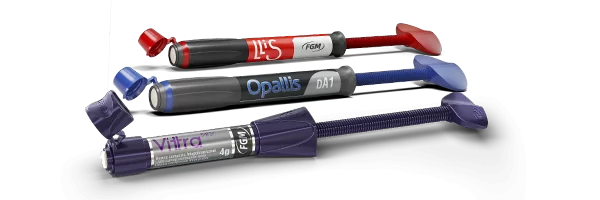
FGM conventional composites: Vittra APS, Opallis and Llis
Flowable composites
Composites with a more fluid consistency and injected into the cavities without the moldalble aspect of conventional composites. They are materials that have evolved and currently have two subcategories:
- Conventional Flowable composites: launched in the mid-1990s. They have a low filler content (35% to 50%), low mechanical properties, high shrinkage and polymerization stress. Indicated for Liners up to 2 mm thick and micro cavities without occlusal stress;
- Flowable composites with a high filler percentage: represent the evolution of conventional Flow composites. They have a filler content in the range of 70% and, therefore, better properties. They have the same indications as conventional Flow composites and indications in some injectable techniques.
There are Flowable opaque composites for use in small thicknesses that can be used occasionally as an alternative to conventional opaque composites. With the increase in interest and evolution of the category, the so-called “injectable” composites showed up, which are Flow composites with a high percentage of filler with a slightly less fluid consistency and more thixotropic (intermediate thixotropy), between conventional and Flow composites, having physical properties closer to conventional composites.
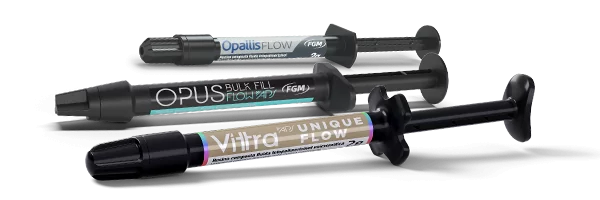
FGM Flowable composites: Opus Bulk Fill Flow APS, Opallis Flow and Vittra APS Unique Flow
Bulk Fill Composites
They were developed with greater depth of polymerization (4 to 5 mm) and less tension and shrinkage of polymerization, facilitating and speeding up the restoration of posterior teeth with larger increments.
On the other hand, they are a little more translucent than Body composites and can, in some cases, make restorations slightly grayish, which is normally not critical in posterior teeth.
In cases of darkened or pigmented substrates, a thin layer of opaque composite can be used.
Bulk Fill resins are available in two consistencies:
- Bulk Fill Flowable : composites for bases or substitutes for dentin, ideal for filling areas of difficult compaction, such as proximal boxes, undercut cusps and internal angles;
- Restorative or mass Bulk Fill: composites that support occlusal loads. They can be used alone in posterior restorations or associated with Bulk Flow resins.
Among the Bulk Fill techniques, we can highlight:
- Bulk & Body: technique in which we use a Bulk Flow base and cover the occlusal portion with a conventional Body composite or Enamel/Dentin. Indicated to obtain the gain in time and convenience of Bulk Fill and the esthetics of conventional composites, generally in larger posterior cavities with greater visibility;
- Restorative Bulk Fill: technique in which we fill with increments of up to 4 to 5 mm in depth and sculpt the restoration, removing excesses. Indicated for simple cavities, such as Class I, as the perfect filling of proximal boxes with this technique becomes challenging;
- Bulk & Bulk: when we associate a base of Bulk Fill Flow and on top we place a layer of restorative Bulk Fill composite. Technique that can be used in all cases, especially in Class II cavities, ensuring the best filling without failures in areas which are difficult to reach. It presents a considerable time reduction even in relation to the Bulk & Body technique.
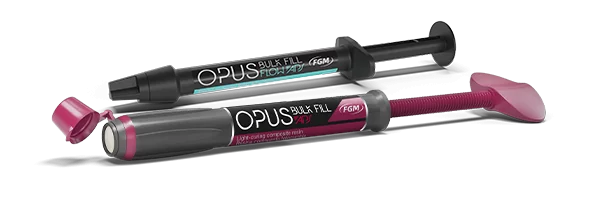
FGM Bulk Fill Composites: Opus Bulk Fill APS and Opus Bulk Fill Flow APS
Unichromatic composites
They are composites with a special characteristic of chromatic reflection of the surrounding cavity walls. That is, with a universal syringe in terms of shade (unichromatic), all scales are reproduced – a real chameleon effect.
Thus, the shade selection step becomes unnecessary. For best results, we need good substrates (in terms of shade) or that these, in the case of pigmentation, are neutralized by the previous application of opaque and a dentine. These materials make the clinician’s life much easier and, as they match the shade of the teeth, they continue to have a good shade similarity even when teeth restored with these materials are whitened.
Conventional unichromatic composites are indicated in incremental techniques for posterior and anterior teeth (small and medium cavities), thin veneers on good substrates or as body enamel on chromatic dentine (double layering).
Flowable unichromatic composites, on the other hand, are indicated for the base under direct restorations, pit and fissure sealant, repair of small defects in enamel, repairs in composite resin, making attachments for invisible orthodontic aligners, tunnel-type preparation, bonding of dental fragments, cervical lesions non-carious and minimally invasive cavity preparation restorations (including small occlusal restorations).
For best results with translucent adhesives without a yellowish effect, the Ambar APS and Ambar APS Universal adhesives should be used together with this material, in order to further favor the chameleon effect.
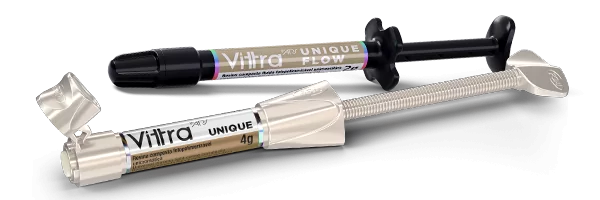
FGM Unichromatic composites: Vittra APS Unique and Vittra APS Unique Flow
Bis-acryl Composites
They are intermediate materials – in properties and esthetics – between acrylic composites and resinous composites, available in injectable consistency, in self-mixing systems of the base with catalyst. That is, usually chemical polymerization.
Its main indications are as provisional restorations for partial or single fixed prostheses and laminated veneers or as a mock-up (simulation of the final result) for veneers and occlusal alterations/reconstructions.
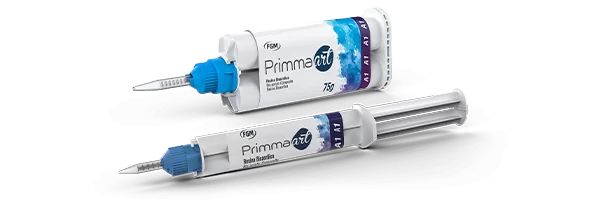
FGM bis-acryl composite: Primmaart
See a study that evaluates the fluorescence of composite resins for enamel and dentin from different commercial brands by clicking here and access further scientific evidence of these and other FGM Dental Group products by clicking here.























